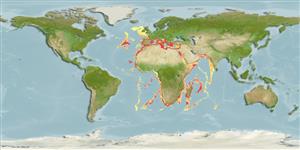Common names from other countries
Classification / Names / Names
Namen | Synonyme | Catalog of Fishes (gen., sp.) | ITIS | CoL | WoRMS
Environment: milieu / climate zone / depth range / distribution range
Ökologie
; tiefenbereich 80 - 3300 m (Ref. 127635), usually 350 - 800 m (Ref. 80214). Tropical, preferred 19°C (Ref. 107945); 49°N - 30°S, 41°W - 75°E
Eastern Atlantic, Mediterranean and Western Indian Ocean: from Brazil to France, south to Natal, South Africa and east to Maldives.
Length at first maturity / Size / Gewicht / Alter
Maturity: Lm 3.2 range ? - ? cm Max length : 22.0 cm TL Männchen/unbestimmt; (Ref. 8); 7.1 cm CL (female); max. veröff. Alter: 6 Jahre (Ref. 80242)
Demersal (Ref. 80214). Maximum length for females from Ref. 80234. Demersal on muddy bottoms of slopes of continental shelf, in zones close to submarine canyons. Moves from depths of 200 m during the night to 800 m during the day, and changes location within the year (Ref. 80214). Feeds on small benthic invertebrates mainly crustaceans and polychaetes and also carrion (Ref. 434).
Members of the order Decapoda are mostly gonochoric. Mating behavior: Precopulatory courtship ritual is common (through olfactory and tactile cues); usually indirect sperm transfer.
Holthuis, L.B. 1980. (Ref. 8)
IUCN Rote Liste Status (Ref. 130435)
CITES Status (Ref. 108899)
Not Evaluated
Not Evaluated
Nutzung durch Menschen
Fischereien: hoch kommerziell
FAO - Fischereien: landings, Artbeschreibung | FIRMS (Stock assessments) | FishSource | Sea Around Us
Tools
Internet Quellen
Estimates based on models
Preferred temperature
(Ref.
115969): 6.6 - 18.3, mean 13.3 (based on 351 cells).
Widerstandsfähigkeit
hoch, Verdopplung der Population dauert weniger als 15 Monate. (K=0.14-0.99; tmax=6).
Prior r = 0.66, 95% CL = 0.44 - 0.99, Based on 7 full stock assessments.
Verwundbarkeit
Low vulnerability (12 of 100).
